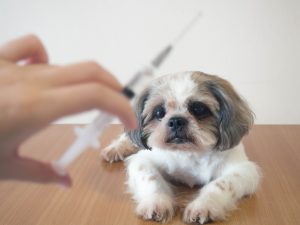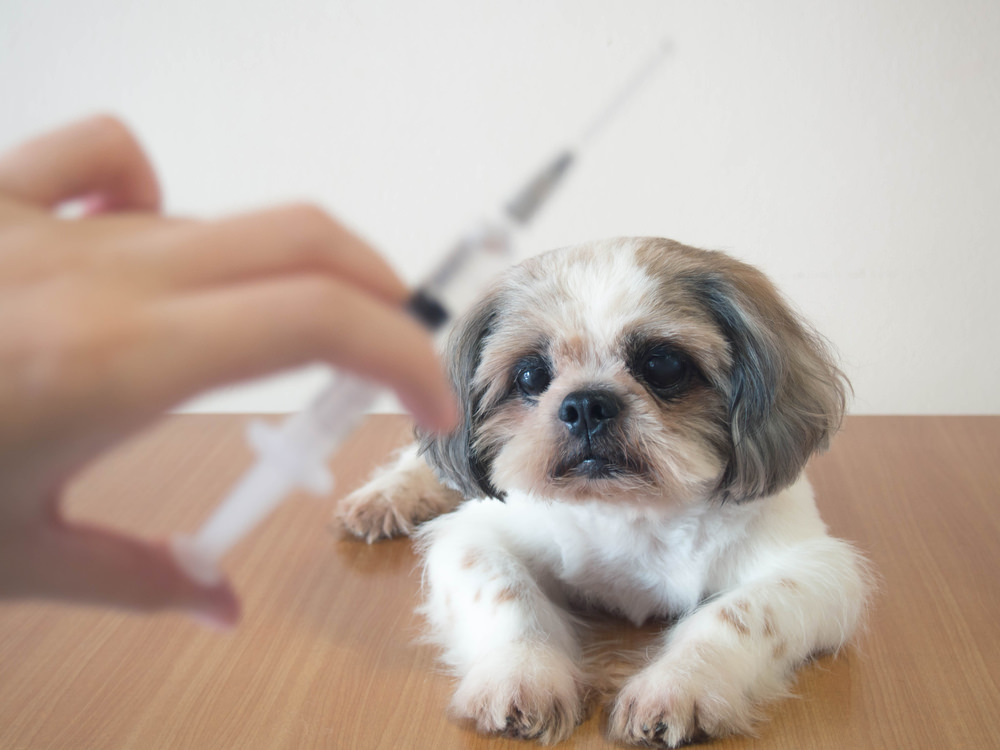Diabetes In Dogs
Free Pet Insurance Comparison
Compare Quotes From Top Companies and Save
Secured with SHA-256 Encryption
Dr. Pippa Elliott BVMS, MRCVS
Veterinarian
Dr Pippa Elliott BVMS, MRCVS is a veterinarian with over 30 years of experience in companion animal practice. In 1987 she graduated from the University of Glasgow, with a degree in veterinary medicine and surgery. She works at Blythwood Vets and the People’s Dispensary for Sick Animals (PDSA). Pippa is an advocate of Fear-Free Practice, an animal addict, and a veterinary writer. She is also w...
Veterinarian
UPDATED: Mar 21, 2024
Pet Insurance U receives compensation from the third parties included on this site. This includes payment for clicks from our site to insurance providers’ sites and quote requests generated. Our rankings and reviews are not affected by payments from the insurance companies. The compensation we receive allows the site to be free and regularly updated. Our goal is to review every pet insurance provider, but not all companies are listed on the site.
And many of the companies we review do not pay us anything. We simply rate, compare and review their plan because we feel it will be valuable to you. Our reviews are guaranteed to be unbiased, professional and advertising compensation does not influence rankings.
We are a free online resource for anyone interested in learning more about pet insurance. Our goal is to be an objective, third-party resource for everything pet insurance related. We update our site regularly, and all content is reviewed by pet insurance experts.
UPDATED: Mar 21, 2024
Pet Insurance U receives compensation from the third parties included on this site. This includes payment for clicks from our site to insurance providers’ sites and quote requests generated. Our rankings and reviews are not affected by payments from the insurance companies. The compensation we receive allows the site to be free and regularly updated. Our goal is to review every pet insurance provider, but not all companies are listed on the site.
And many of the companies we review do not pay us anything. We simply rate, compare and review their plan because we feel it will be valuable to you. Our reviews are guaranteed to be unbiased, professional and advertising compensation does not influence rankings.
On This Page
Diabetes in dogs can catch any dog owner by surprise with its sudden onset. It’s upsetting to see the symptoms and then hear the diagnosis.
In fact, one in every 500 dogs is diagnosed with diabetes. While diabetes is manageable, it can be fatal if left untreated.
Diabetes in dogs generally occurs when a dog is 7 to 10 years old, but can afflict younger dogs. Female dogs are 70 % more likely to develop diabetes than males.
Need Pet Insurance?
FACT: Pet insurance pays up to 90% of vet bills when your pet is sick or injured!
Some Breeds That Are At Higher Risk Of Diabetes
- Poodles
- Schnauzers
- Dachshunds
- Australian Terriers
- Labradoodles
- Springer Spaniels
- Samoyeds
- Golden Retrievers
Enter your ZIP code below to view companies that have cheap pet insurance rates.
Secured with SHA-256 Encryption
What Is Diabetes In Dogs?

Diabetes mellitus (diabetes), similar to human diabetes, is caused by a lack of the pancreatic hormone, insulin, which affects the dog’s ability to digest or utilize the energy that is gained from sugars and starch.
A normal dog’s bodily functioning is able to break down glucose which then fuels the dog’s body, and the insulin is required to do so.
When glucose is unable to be converted to insulin, it can build up and cause kidney damage, damage to the eyes, heart and even nervous system. When diabetes is not treated, it can cause a stroke, blindness, and even nerve damage.
Diabetes is not curable but can be maintained with medication, exercise, and a healthy diet.
Read more: Does pet insurance cover diabetes?
Related: 10 Things You Must Know Before You Buy Pet Insurance
Types Of Diabetes in Dogs
Type 1
The more severe and dangerous diabetes is when the dog cannot produce insulin. Approximately 99% of all dogs that have Type 1 diabetes, the usual treatment is insulin.
Type 2
The dog’s body can produce insulin, but the cells are not able to process it correctly. Type 2 can usually be treated with oral medications.
Symptoms of Diabetes in Dogs
- Excessive thirst
- Excessive urination
- Weight loss
- Hungry all the time
- Anorexia or complete loss of appetite
- Lethargy and depression
- Vomiting
Real Cost Savings from PetFirst Clients

Luna
PetFirst saved his parents
$6,712
A happy energetic Luna one morning couldn’t hold her food down. After months of multiple costly vet visits to specialists and an endoscopy, the problem was discovered and fixed. Luna put 22 pounds back on in no time and her parents were grateful for having PetFirst by their side to pay the bills.
Enter your ZIP code below to view companies that have cheap pet insurance rates.
Secured with SHA-256 Encryption
Treatment And Cost Of Dog Diabetes
When your dog is diagnosed with diabetes, your veterinarian will give you instructions on how to treat your dog at home.
The home routine usually means that you will have to administer daily doses of insulin, time your dogs’ feedings as well as monitoring your dog’s blood glucose. In most cases, a specific diet is also recommended.
Insulin
Insulin is the most common form of treatment for Type 1 Diabetes. Oral medication is not prescribed.
Insulin is injected under the dog’s skin with a syringe or an insulin pen (which is a pre-filled syringe). Your veterinarian will give you a recommendation of the best type of insulin and syringe to purchase for your dog. And, of course, directions on how to administer the shots.
The injections of insulin are given to your dog with a very small needle. You will usually give your dog an injection 1 to 2 times daily – at the same time every day.
The amount of insulin that will be prescribed depends on the dog’s weight, size and how severe the diabetes is. The monthly cost of insulin typically ranges from $25 – $90.
Your vet can prescribe insulin and there are many online prescribed pharmacies that have lower prices than your vet. But, because insulin needs to be kept refrigerated, it needs to be guaranteed overnight shipping and that can also increase the cost.
Syringes
Insulin needs to be injected with a sterile syringe which can only be used once. Depending on how much insulin you need to give your dog, the monthly cost of syringes can range from $8 to $15 a month.
Glucose Monitoring
When you start your dog on insulin, your vet will want to observe your dog’s glucose levels to make sure the dosage is right.
A very low dosage is generally given at the start and through testing, your vet will be able to determine if the prescribed amount is right or needs adjusting.
Of course, you want the right amount of insulin to keep the glucose level down, but not too much that your dog can’t handle that either.
There are glucose meters that can be used to monitor your dog’s insulin levels at home. A glucose machine ranges anywhere from $30 to $500. And, if you decide to have your vet do the testing, the costs can range from $15 to $40 a month.
Dog Food For Diabetes
Dogs that have diabetes will be on a prescribed food that is specifically for a diabetic dog. Your vet will recommend the best food for your dog and his condition. Most prescribed dog food is about 2 to 3 times the normal price of dog food.
For example, the popular Hill’s Prescription Diet for Digestive/Weight /Glucose Management costs about $80 for dry food and a case is approximately $45.
Diabetic dogs need to eat right before their insulin injection and at the same time each day.
Veterinary Visits
When you have a diabetic dog, you will be going to the veterinarian’s office at least once every four months.
Vets can only prescribe insulin for a 3 to 4-month window and you will want to monitor your dog’s health often.
Depending on your vet or whether you have pet insurance, a vet bill can be free of charge or up to $90 a visit.

Enter your ZIP code below to view companies that have cheap pet insurance rates.
Secured with SHA-256 Encryption
Pet Insurance for Dog Diabetes
If you have a diabetic dog, hopefully, you already have pet insurance before the condition started.
While this is an additional $30 – $40 a month, if you have pet insurance and then your dog is diagnosed with diabetes, you will save money not only monthly, but overall for the duration of your dog’s life.
With all the insulin needed, testing, vet visits and even prescribed food, pet insurance can save you thousands of dollars. This is the perfect example of when pet insurance is not only a price saver but could be a lifesaver.
And another reason why you should insure your dog at a young age before any conditions are considered pre-existing.
Diabetes in dogs is manageable. It’s important to keep up with your dog’s daily walks, watch your dog’s weight look for any changes in your dog’s health or demeanor.
Make sure to keep up with the vet visits and if properly monitored, your dog can still a long, happy life.
Read more: How much does a vet visit cost?
Other articles you may find helpful:
Is Exotic Pet Insurance Necessary?
The Best Pet Insurance By State
Fun Facts, Dog FAQ, And Unsolicited Dog Advice
5 Training Commands to Save Your Dog’s Life
The Ultimate Guide to Safe Foods for Dogs
We get it, your dog is like your child and when your puppy or dog has health problems it is scary. Luckily there is pet insurance companies that will help you pay for any veterinarian care they made need. Checkout the best puppy and dog pet insurance companies and learn about common puppy health issues and ailments in older pets.
Common Health Problems:
Chronic Active Hepatitis in Dogs
Cruciate Ligament Tear in Dogs
Degenerative Myelopathy | Spinal Cord Disease In Dogs
Dementia in Dogs | Canine Cognitive Dysfunction
Dog Comedones (Schnauzer Bumps)
Dog Diarrhea: What Can You Do To Help?
Gallbladder Obstruction in Dogs
Heart Murmurs In Dogs | How To Identify Them
Intervertebral Disc Disease In Dogs
Nasal Solar Dermatitis In Dogs
Progressive Retinal Atrophy In Dogs
The Dog Flu – Symptoms & Treatment for Canine Influenza

Frequently Asked Questions
What is the significance of the “Secured with SHA-256 Encryption” message on the website?
The “Secured with SHA-256 Encryption” message indicates that the website uses a secure connection to protect user data. SHA-256 Encryption is a cryptographic hash function that ensures the confidentiality and integrity of data transmitted between the user’s browser and the website.
What are some common signs of diabetes in dogs?
Common signs of diabetes in dogs include increased thirst and urination, weight loss, changes in appetite, lethargy, and recurrent urinary tract infections. If you observe these symptoms in your dog, it’s crucial to consult a veterinarian for proper diagnosis and treatment.
How prevalent is diabetes in dogs, and at what age does it typically occur?
Approximately one in every 500 dogs is diagnosed with diabetes. While it generally occurs when a dog is 7 to 10 years old, it can affect younger dogs. Female dogs are 70% more likely to develop diabetes than males.
What is the role of insulin in managing diabetes in dogs?
Diabetes in dogs, similar to human diabetes, is caused by a lack of the pancreatic hormone, insulin. Insulin is essential for breaking down glucose to fuel the dog’s body. In diabetes, the body cannot properly use insulin, leading to various health issues. While diabetes is not curable, it can be managed with medication, exercise, and a healthy diet.
What are the types of diabetes in dogs, and how are they treated?
There are two types of diabetes in dogs: Type 1, where the dog cannot produce insulin, typically treated with insulin injections, and Type 2, where the body can produce insulin, but the cells cannot process it correctly, usually treated with oral medications.
How is diabetes in dogs treated, and what are the associated costs
Treatment for dog diabetes involves administering insulin, monitoring blood glucose, and maintaining a specific diet. The costs include insulin (monthly cost of $25-$90), syringes (monthly cost of $8-$15), glucose monitoring (device cost $30-$500, or vet testing $15-$40 monthly), and prescribed diabetic dog food (about 2-3 times the normal dog food price).
Is pet insurance beneficial for dogs with diabetes?
Yes, having pet insurance for a diabetic dog can be beneficial. It covers a significant portion of vet bills, including insulin, testing, prescribed food, and veterinary visits. Pet insurance can potentially save dog owners thousands of dollars over the course of their dog’s life.
What is the role of pet insurance in managing the costs associated with diabetic dogs?
Pet insurance can help manage the costs of treating diabetic dogs by covering expenses such as vet visits, insulin, syringes, glucose monitoring devices, and prescribed food. It provides financial assistance and ensures that pet owners can provide the necessary care without facing a significant financial burden.
Enter your ZIP code below to view companies that have cheap pet insurance rates.
Secured with SHA-256 Encryption
Dr. Pippa Elliott BVMS, MRCVS
Veterinarian
Dr Pippa Elliott BVMS, MRCVS is a veterinarian with over 30 years of experience in companion animal practice. In 1987 she graduated from the University of Glasgow, with a degree in veterinary medicine and surgery. She works at Blythwood Vets and the People’s Dispensary for Sick Animals (PDSA). Pippa is an advocate of Fear-Free Practice, an animal addict, and a veterinary writer. She is also w...
Veterinarian
We are a free online resource for anyone interested in learning more about pet insurance. Our goal is to be an objective, third-party resource for everything pet insurance related. We update our site regularly, and all content is reviewed by pet insurance experts.


